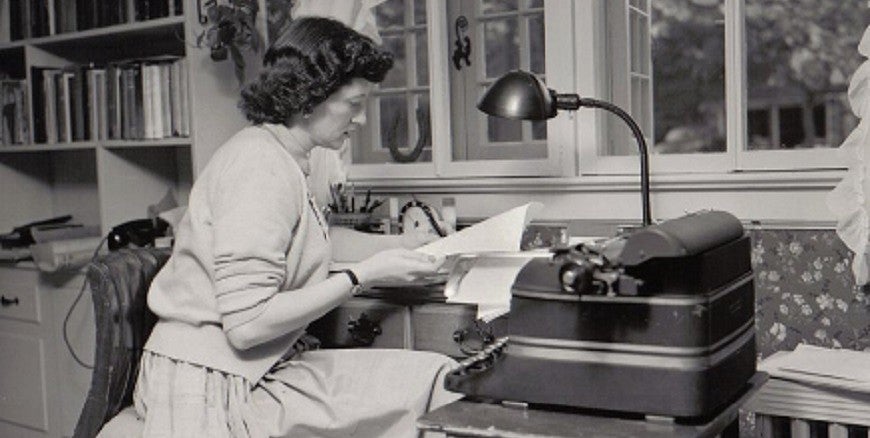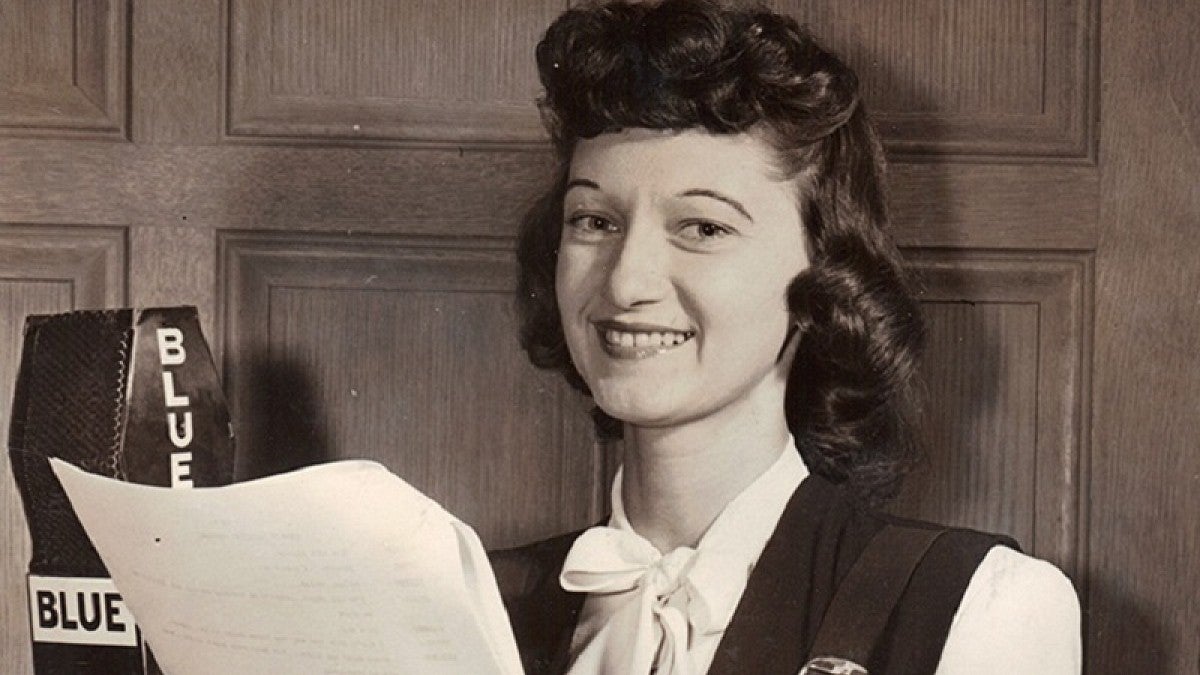On exhibit in Knight Library through the summer, “Comedy of the Commonplace: The Sitcom Genius of Peg Lynch” celebrates the legacy of a true innovator and trailblazer in the fields of broadcasting and popular entertainment.
In the 1950s “Ethel and Albert” was among the most popular shows on the fledgling medium of television, and Lynch, whose papers are held in the UO Libraries’ special collections, was its creator, writer and star. She also negotiated to retain creative control and complete ownership of her program in an era when women in media seldom were afforded such autonomy.
RELATED LINKS
“Unlike many male producers of her time, Peg Lynch did not condescend to female audiences, and she received thousands of fan letters from women who expressed their enthusiasm for the intelligent content of her programs,” said Carol Stabile, professor of women’s, gender and sexuality studies and author of “The Broadcast 41: Women and the Anti-Communist Blacklist.”
Asked why a half-century-old TV sitcom should still hold relevance for contemporary audiences, Stabile cited data from the Center for the Study of Women in Television and Film: In 2016-17 women comprised just 28 percent of executive producers, 33 percent of writers and 17 percent of directors on television programs.
“Within those numbers, women of color are especially underrepresented,” Stabile said. “Some of the things that Peg Lynch struggled for are struggles that continue for women in television today.”
Born in Nebraska in 1916, Lynch gravitated to the emerging medium of radio at an early age and landed her first professional job as a scriptwriter while still in high school. After graduating from college she worked at a series of small-town radio stations; her husband-and-wife characters Ethel and Albert were introduced in three-minute sketches on KATE radio in Albert Lea, Minnesota.
In 1944, Lynch made a bold move to New York City with just $500 in hand and took an apartment overlooking fashionable Gramercy Park, in a building where many actors lived. After a few months of shopping the script for “The Private Lives of Ethel and Albert” around, she was writing and starring in her own nationally broadcast series.
“Ethel and Albert” debuted on ABC radio in 1944 and moved to NBC television in 1950. In its heyday it was widely regarded as the top domestic comedy by critics and audiences alike.
“I base my show on the little things in life,” Lynch told The New York Times. “I believe that people like to find out that other people have some of the same problems they do.”
Times entertainment critic Jack Gould praised Lynch’s “uncanny knack for catching the small situation in married life and developing it into a gem of quiet humor. The charm of ‘Ethel and Albert’ is that they could be man and wife off the screen.”
Unlike many shows of its era, “Ethel and Albert” avoided female stereotypes and broad comedic techniques like insults, running gags and funny voices. In their place, Lynch conceived a humor grounded in real life. Her warm and affable jokes were joined with a modernist storytelling sensibility; she claimed to have little use for plots, saying, “Things at home do not have a beginning, a middle and an end.”
Over the course of her career Lynch would write and produce more than 11,000 scripts. She began donating her papers to the University of Oregon Libraries in the 1960s. The process of acquiring the collection continued through 2013, when UO Libraries staff members made three trips to Lynch’s home in Massachusetts to collect most of her remaining papers and capture video of her oral history.
“At 97 she was remarkably talkative, insightful and ever the comedian,” recalled Marilyn Reaves, a manuscripts archivist who made the trip. Now retired, Reaves returned to the library to serve as author of the Peg Lynch exhibit and its co-curator alongside Linda Long, the special collections’ curator of manuscripts.
“Then and now, our interest was in preserving her work, her legacy, and in the research value of the materials,” Long said. “In addition to her original radio and television scripts, her collection includes correspondence, business records, professional and family photographs, travel mementos, advertising promotions and many kinescopes.”
These early 16mm film recordings of “Ethel and Albert” are the sole visual record of these shows, which were performed and broadcast live over the air. Only a handful of the programs have ever been converted to digital formats.
“Compared to many other ’50s shows like ‘I Love Lucy’ or ‘Leave It to Beaver,’ fewer people today remember ‘Ethel and Albert’ because they didn’t grow up watching reruns,” Long observed.
While Lynch’s ownership of her show allowed her to exercise an enviable degree of creative control, an unintended consequence was that “Ethel and Albert” never entered syndication in later decades.
“I’m not quite sure why she didn’t want it to be syndicated,” Long said. “I know she always wanted to control what happened with her show. Maybe to be syndicated would have meant giving up her rights to it somehow, at least in Peg’s estimation.”
Lynch was also protective of her work-life balance. In 1948 she married Odd Knut Ronning, a pulp and paper engineer, and daughter Elise Astrid soon joined the family. Lynch was getting overtures from Hollywood by this time, but she was reluctant to move her young family across the country.
Instead she continued to live in a New York apartment during the week, working long hours, and returned every weekend to a “conventional” suburban family life in Stamford, Connecticut. Magazine profiles of the 1950s often depicted Lynch both at work and at home; TV Radio Mirror crowned her “Mrs. Everywoman of 1958.”

“Ethel and Albert” had a six-year run on television, then returned to radio, where Lynch would write and perform the character of Ethel on a variety of programs through the 1970s. In 1979 the series was adapted for British television as “Chintz.” Despite the couple’s absence from American TV in later decades, “Ethel and Albert” were fondly remembered by original fans, and into her 90s Lynch continued to perform at Old Time Radio and Television Conventions across the country.
“The show’s focus on the minutiae of everyday life — in this case, marriage — was very different from what came after it on TV,” Stabile said. “In many ways, it was ahead of its time. Someone at the Women in Media Symposium this past spring said that the pace and dialogue in ‘Ethel and Albert’ reminded them of ‘Seinfeld.’”
Reaves said a major motivation in preparing the exhibit was her desire to raise awareness of Lynch’s remarkable life story and creative legacy to a wider audience, especially students and young people.
“She had the talent, the gumption and the determination to make her way to the top in an industry that was not very welcoming to women," Reaves said. "I found it very inspiring for me, and I think it will be very inspiring to young women now, in whatever field, but particularly in media where there are still many hurdles to overcome.”
—By Jason Stone, University Communications


